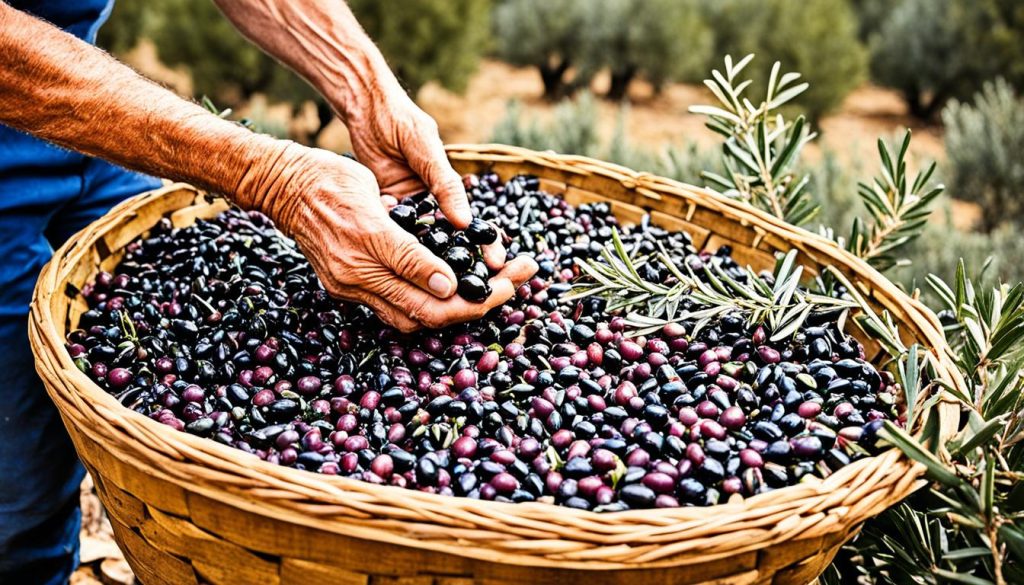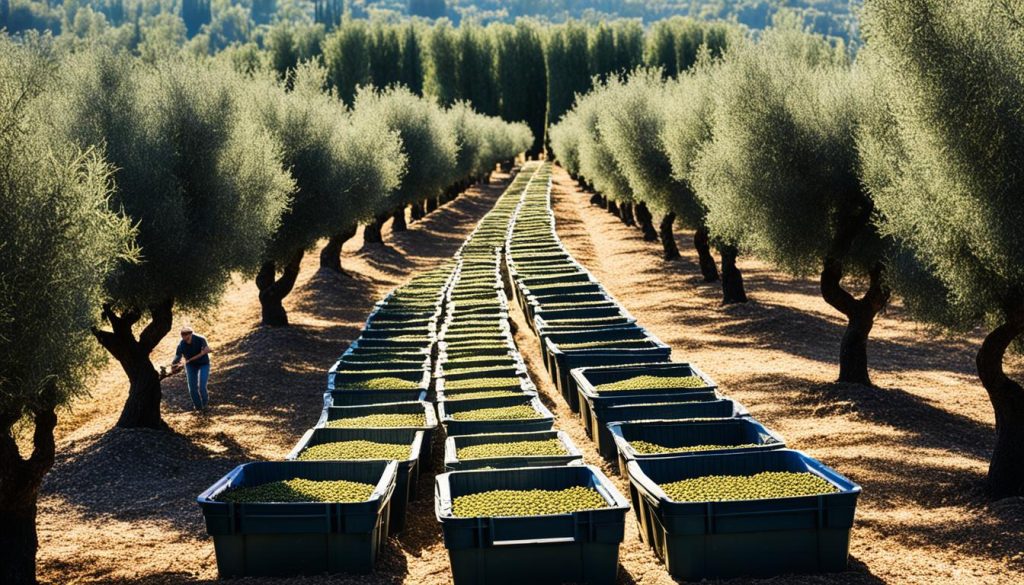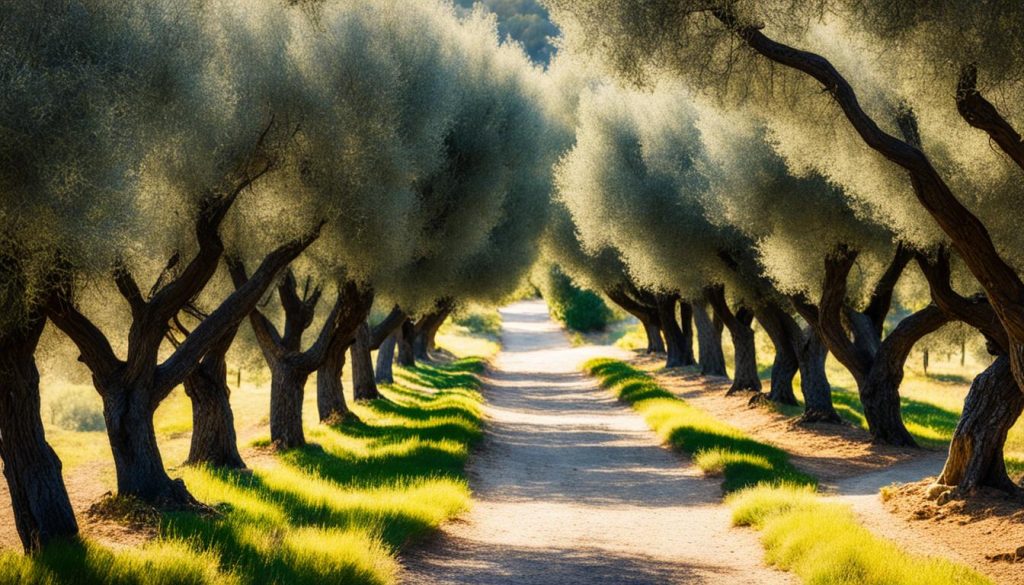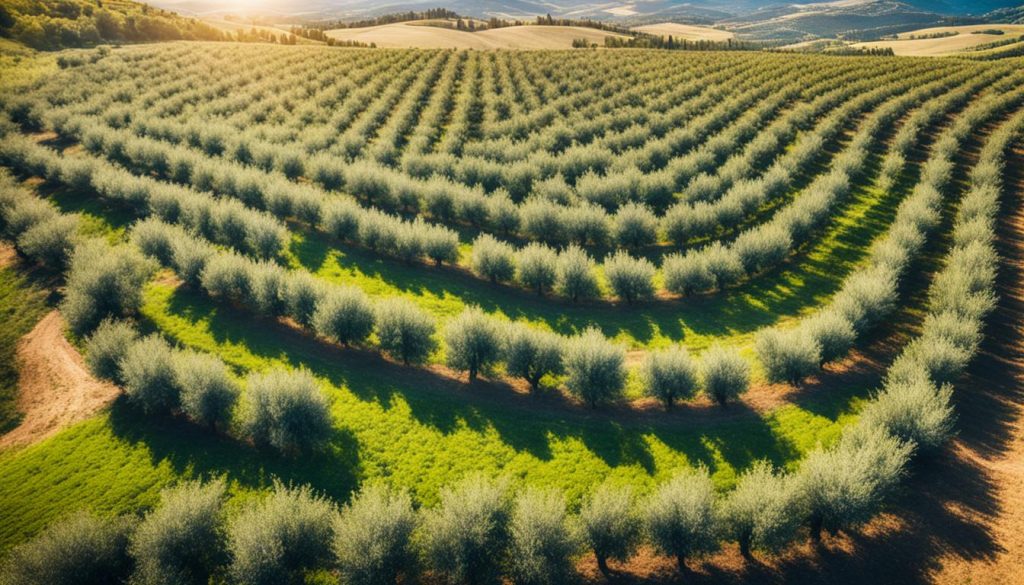Olive oil is a key part of Italian food culture. It’s vital in traditional Italian cooking. From the first press to the final touch on pasta, it brings out the best in Italian dishes.
Italy has loved olive oil for centuries. It’s a big producer of olive oil, known for its quality and variety. Each region has its own special olive oils, showing off their unique land and methods.
The olive oil business in Italy is more than a job; it’s a tradition. Small family farms, or frantoi, produce some of the world’s best olive oils. Skilled workers put their heart into it.
Let’s dive into the world of Italian olive oil. We’ll look at its history, types, how it’s made, and its economic impact. We’ll also talk about its health benefits and how it’s used in cooking. Plus, we’ll cover olive oil tourism and quality certifications.
This journey will highlight olive oil’s big role in Italian food culture. It’s a key part of Italy’s culinary excellence.
Key Takeaways:
- Olive oil is a key ingredient in Italian cuisine, central to its culinary traditions.
- Italy is a big producer of olive oil, known for its quality and variety.
- The olive oil business in Italy is based on tradition and authenticity, with small family farms playing a big part.
- Learning about olive oil’s history, types, production, and economic impact shows its importance.
- Olive oil tourism, health benefits, and certifications help keep Italian olive oil at a high standard.
History of Olive Oil in Italy
Olive oil has been a key part of Italy’s food culture for centuries. It’s known for its top-notch quality, unique taste, and deep history. Let’s dive into the story of how Italy produces olive oil and its big impact on the country.
Ancient Origins
The story of olive oil in Italy goes way back to ancient times. The Etruscans and Greeks, who lived in Sicily and southern Italy, first started making it. They saw the value in olive trees and worked out how to get oil from them.
Over time, olive oil became a big part of Italian life. It was used in cooking, religious ceremonies, and even for health reasons. It became a sign of wealth, health, and Italian identity.
Cultivation and Extraction Methods
Italian olive oil is famous for its great taste and quality. This comes from the careful way farmers and producers grow and make the oil.
Italy has many types of olive trees, each adding its own special flavor to the oil. From the strong Coratina olives in Puglia to the gentle Frantoio olives in Tuscany, each region has its own unique olives. These give Italian olive oil its excellence.
Olives were once picked by hand and chosen for the best ripeness. Then, they were pressed to get the oil. This was done using stone mills or modern machines. Cold-pressing, which keeps the oil’s quality high, is a common method in Italy.
Cultural and Economic Impact
Olive oil has greatly influenced Italian culture and economy over the years. It has supported farmers and local communities for generations.
It’s also a key part of Italian cooking. Chefs and home cooks use it for its special flavors and health benefits. Olive oil is essential for many dishes, from topping bruschetta to making tasty dressings.
In conclusion, the story of olive oil in Italy shows a deep bond with the land and food traditions. From ancient times to now, Italian olive oil is seen as a precious ingredient that captures the spirit of Italian cuisine.
Regional Varieties of Italian Olive Oil
Italian olive oil is famous worldwide for its top-notch quality and diverse tastes. Each region in Italy has its own special olive oil. These oils have unique flavors and aromas that make Italian food special.
Tuscany
Tuscany, in central Italy, is known for its excellent olive oils. Its oils have fruity and herbaceous tastes with a spicy kick. They use olives like Frantoio, Leccino, and Moraiolo, making the oil balanced and smooth.
Liguria
Liguria, along the Italian Riviera, makes olive oil that’s light and fragrant. The Taggiasca olives used give a buttery, sweet taste with almond hints. This oil is great for pesto, seafood, and salads.
Sicily
Sicily, in southern Italy, is famous for its strong olive oils. The sun makes the olives here taste bold, spicy, and fruity. These oils are perfect for hearty dishes and grilled veggies.
Puglia
Puglia, in southeastern Italy, produces a lot of olive oil. Its oils taste fruity and grassy with a mild bitterness. You can use it for cooking, dressing salads, or enhancing dishes.
These are just a few examples of Italy’s olive oil varieties. Each region’s oils bring different flavors and aromas to Italian food. From Tuscan’s peppery taste to Puglia’s versatile oil, each one offers a unique experience.
Exploring Italian olive oil varieties is like a journey through Italy’s beautiful landscapes. The unique tastes and smells of these oils make Italian food even more special. They take dishes to new heights of flavor and fun.
Olive Oil Production Methods

Olive oil production uses different methods to get the oil from olives. These methods mix old ways with new tech to please olive oil fans everywhere.
1. Olive Cultivation
The first step is growing olive trees. The type of olives and how they are grown affect the oil’s quality and taste. Good soil care, watering, and pest control are key for healthy trees and top-quality olives.
2. Olive Harvesting
Harvesting olives at the right time is key for great oil. Olives can be picked by hand or machines. Handpicking picks the best olives, while machines help with large amounts. Olives are quickly taken to the mill to keep quality high.
3. Olive Pressing
After picking, olives are pressed to get the oil. Old stone mills and new centrifuges are used. The aim is to get the oil from the pulp and water, making a pure, tasty oil.
4. Storage and Bottling
Once extracted, oil is stored in steel tanks or barrels to stay fresh. Keeping the right temperature and light is vital for quality. Before bottling, the oil is filtered to remove bits, making it clear and clean for buyers.
5. Quality Control
Quality checks are strict to ensure the oil meets high standards. These standards look at acidity, taste, and certifications. Tests are done from the farm to the bottle, making sure only the best oils are sold.
| Production Method | Characteristics |
|---|---|
| Traditional Stone Mill | Slow extraction process that preserves the aromas and flavors of the olives. |
| Centrifugation | Rapid separation of oil from olive paste, ensuring high-quality yield within a short period. |
| Decantation | Natural settling and separation of oil from the olive paste, resulting in a smooth and mellow flavor. |
| Continuous Method | Modern, efficient process that allows for large-scale production while maintaining quality standards. |
Each method of making olive oil gives us a wide range of tastes and qualities. From the traditional stone mill’s deep smells to the quick process of centrifugation, these ways help bring out the best in the olives. They make a liquid gold that makes food special.
Extra Virgin Olive Oil: The Gold Standard
In Italian cuisine, extra virgin olive oil is the top choice. It’s known for its top-notch quality and unique taste. This premium oil comes from the first pressing of olives without chemicals or high heat. This method keeps the olives’ flavors, smells, and health benefits, making the oil exceptional.
Extra virgin olive oil stands out for its great taste and strict quality checks. To be called “extra virgin,” the oil must come from olives, have less than 0.8% acidity, and taste and smell perfectly. These rules make sure every bottle of extra virgin olive oil is of the highest quality.
Italy is famous for its top extra virgin olive oils. Its varied landscapes and soils give each region its own flavor. From the strong oils of Tuscany to the fruity ones of Sicily, each area has its own special olive oil.
| Region | Characteristics |
|---|---|
| Tuscany | Robust, Peppery |
| Sicily | Fruity, Grassy |
| Umbria | Butter, Nutty |
| Liguria | Light, Delicate |
| Puglia | Earthy, Spicy |
The mix of soil, climate, and olive types in each area makes the extra virgin olive oils unique. This variety lets chefs and home cooks add different flavors to their dishes. It makes cooking truly special.
When picking extra virgin olive oil, choose well-known brands and look for certifications. The Protected Designation of Origin (PDO) label means the oil comes from a certain area and is made the traditional way.
Next time you’re in the kitchen, remember that extra virgin olive oil is a key ingredient in Italian cooking. It adds rich flavor, health benefits, and cultural value to dishes. It’s a big part of the Mediterranean diet, showing Italy’s love for olive oil.
Culinary Uses of Olive Oil in Italian Cuisine
Olive oil is key in Italian cooking, known for its rich taste and health perks. It’s versatile and a must-have in many dishes, adding depth and character to Italian food.
Italian cooking is all about simplicity, letting top-quality ingredients speak for themselves. Olive oil enhances the natural tastes of fresh veggies, meats, and seafood. Its smooth feel and gentle scent are ideal for dressings, marinades, and sauces.
In starters, olive oil stars in bruschetta. Toasted bread is topped with tomatoes, basil, and garlic, all drizzled with extra virgin olive oil. This dish highlights olive oil’s power to make simple ingredients shine.
Olive oil is vital in pasta, both in the dough and the sauce. Pasta all’olio di oliva uses olive oil, garlic, and chili for a tasty meal. Olive oil sauces like olive oil and garlic or olive oil and lemon add a light, refreshing touch to pasta.
In main courses, olive oil is used for sautéing, roasting, and frying. It adds a rich taste to chicken piccata or grilled vegetables. In Chicken Parmigiana or Eggplant Parmigiana, it’s drizzled over the breaded meat or veggies before baking, making them golden and crispy.
Olive oil even finds its way into desserts. Italian treats like olive oil cake and olive oil gelato show how versatile this ingredient is, adding a subtle richness to sweets.
Olive oil’s many uses make it a cornerstone of Italian cuisine. It reflects Italy’s dedication to quality and its love for creating tasty, memorable meals.
The Economic Impact of the Olive Oil Business in Italy

Italy’s olive oil industry is a big deal for the country’s economy. It adds a lot to the GDP and helps create jobs. With its long history of growing and making olive oil, Italy is a top player in the global market. This has led to economic growth and new export chances.
Olive oil production is a key source of income for farmers and producers. It also creates jobs from growing olives to bottling the oil. This supports many people, especially in rural areas where olive groves are common.
Italy doesn’t just use olive oil at home. It sends a lot of it to other countries too. This makes it a big deal for the economy. People all over the world love Italian olive oil for its quality. This makes it a valuable export and helps Italy’s trade balance.
The olive oil industry also brings in tourists. They come to see the beautiful olive groves and vineyards. Activities like olive oil tastings and farm visits let tourists experience the local culture and food. This helps the local economy a lot.
There are also industries like packaging and marketing that support the olive oil business. They provide important services for making, distributing, and promoting Italian olive oil. This creates more jobs and helps the economy grow.
Italy’s success in the olive oil industry comes from its great climate, soil, and olive types. The country’s focus on quality, traditional ways of making olive oil, and strict rules also help it stand out. This makes Italy known for top-notch olive oil.
Key Points:
- The olive oil industry significantly contributes to Italy’s GDP and employment generation.
- Italy’s olive oil exports play a crucial role in its positive trade balance.
- Olive oil tourism drives economic growth and offers visitors unique experiences.
- Associated industries such as packaging, transportation, and marketing benefit from the olive oil business.
The olive oil business in Italy is doing well. It brings in a lot of money and helps keep Italy’s farming and food traditions alive.
Challenges Faced by the Olive Oil Industry
The olive oil industry is a key part of Italian food culture. Yet, it faces big challenges that threaten its future. These come from many areas, making the industry need to change and find new ways to succeed.
1. Climate Change
Climate change is a big problem for olive oil production. Warmer temperatures and changing weather patterns hurt olive tree growth and olive quality. Heatwaves, droughts, and unpredictable rain make it hard to produce good olive oil.
This issue doesn’t just reduce how much olive oil we get. It also changes the taste, making Italian olive oil unique. So, the quality of the oil is at risk.
2. Pests and Diseases
Olive trees are often attacked by pests and diseases. This harms the health and productivity of olive groves. Pests like the olive fruit fly and diseases like olive quick decline syndrome (OQDS) can cut yields and lower quality.
To fight these problems, new ways to control pests and diseases are needed. Using integrated pest management, biological control, and researching disease-resistant trees are key steps. This helps lessen the damage from pests and diseases.
3. Counterfeit Products
Another big issue is fake olive oil. Some producers sell oil that’s not really olive oil or mislabel it. This hurts real olive oil producers’ sales and damages the industry’s reputation.
To stop this, strict rules, quality checks, and clear supply chain information are vital. Supporting schemes like Protected Designation of Origin (PDO) helps consumers choose the right oil. This keeps genuine Italian olive oil safe.
4. Sustainable Practices
The industry must adopt sustainable farming to protect the environment and keep olive groves going. Organic and biodynamic farming are good for the land and produce better olives and oil.
Investing in research, using sustainable irrigation, and cutting down on waste are important. These actions help make olive oil production more sustainable. They lessen the effects of climate change, reduce pesticide use, and boost long-term success.
Certifications and Labels: Ensuring Quality Assurance
Certifications and labels are key for Italian olive oil quality and authenticity. They help consumers trust the product. Various groups set strict standards to protect Italian olive oil. This shows the commitment of producers to quality.
The Consortium for the Protection of Extra Virgin Olive Oil (DOP) is a big name in Italy. It makes sure olive oil producers follow strict rules and quality checks. The DOP label means the oil comes from a certain area, made the traditional way, and is top quality. It keeps consumers safe from fake products and highlights the unique taste of Italian olive oil.
Another important label is the IGP (Protected Geographical Indication). IGP-certified olive oil is made, processed, and prepared in a specific area. This tells consumers about the oil’s origin and quality. It helps keep regional traditions alive and adds value to the oil.
Organic certification means the olive oil is made without synthetic pesticides, fertilizers, or genetically modified organisms. It’s great for those who want a sustainable and natural choice. Choosing organic olive oil supports the environment and matches their values.
When buying Italian olive oil, look for these certifications and labels. They show the oil’s quality and authenticity. These marks are important for both local and international buyers. They ensure they’re getting real Italian olive oil and supporting ethical producers.
Common Certifications and Labels for Italian Olive Oil
| Certification/Label | Description |
|---|---|
| DOP | The Consortium for the Protection of Extra Virgin Olive Oil label ensures that the olive oil is produced in a specific region following traditional practices and meets the highest standards of quality. |
| IGP | The Protected Geographical Indication label guarantees that the olive oil is produced, processed, and prepared in a specific geographic area, ensuring its origin and quality. |
| Organic | The organic certification ensures that olive oil is produced without the use of synthetic pesticides, fertilizers, or genetically modified organisms, offering a more sustainable and natural option. |
Olive Oil Tourism: A Journey Through the Olive Groves

Olive oil’s popularity is growing, making olive oil tourism a hit. It lets visitors dive into the history and making of this golden liquid. This experience connects you with Italian culture, lets you see beautiful olive groves, and teaches you about making olive oil.
Visiting olive groves is a key part of olive oil tourism. Here, you see the Mediterranean’s beauty and learn about the olive trees. Guides explain how the trees are grown, how olives are picked, and how the land affects the oil’s taste.
Then, there’s the chance to see traditional mills where olives are turned into oil. These mills show old and new ways of making olive oil. Tours show every step, from washing to separating the oil from the paste.
Tasting different olive oils is a big part of the experience. You’ll try oils with various tastes, from light to strong. Experts help you learn to spot quality oils and match them with food.
Olive oil tourism also helps keep Italian food traditions alive. By supporting local growers and mills, you help the olive oil industry grow sustainably. This protects the ancient olive groves that are key to Italy’s farming history.
Olive oil tourism is a journey for all your senses. It makes you appreciate the skill in making this special ingredient. So, why not start an olive oil adventure and discover the secrets of the groves?
| Benefits of Olive Oil Tourism: | Reasons to Experience Olive Groves: |
|---|---|
|
|
Health Benefits of Olive Oil
Olive oil is a key part of Mediterranean cuisine, known for its health benefits. It’s full of nutrients that make it a great addition to a healthy diet.
Heart Health
Olive oil is packed with monounsaturated fats. These fats are good for the heart by lowering bad cholesterol and raising good cholesterol. Eating olive oil regularly can help prevent heart disease, strokes, and high blood pressure.
Reduced Risk of Chronic Diseases
Research shows that olive oil can lower the risk of diseases like type 2 diabetes, some cancers, and Alzheimer’s. Its antioxidants protect cells and fight inflammation and oxidative stress.
Antioxidant Properties
Olive oil is full of antioxidants like vitamin E and phenolic compounds. These help neutralize harmful free radicals in the body. They protect cells, reduce inflammation, and support overall health.
Contribution to a Balanced Diet
Olive oil is a big part of the Mediterranean diet, known for its health benefits. This diet focuses on whole grains, fruits, vegetables, lean proteins, and healthy fats like olive oil. It’s linked to a lower risk of heart disease, obesity, and chronic conditions.
| Health Benefits of Olive Oil | |
|---|---|
| Promotes heart health by reducing bad cholesterol levels | ✓ |
| Decreases the risk of chronic diseases such as type 2 diabetes and certain cancers | ✓ |
| Contains antioxidants that help combat inflammation and oxidative stress | ✓ |
| A key component of the Mediterranean diet, associated with numerous health benefits | ✓ |
Adding olive oil to your daily meals can boost your health. It protects your heart and lowers the risk of chronic diseases. So, try using this golden oil in your cooking and enjoy its great taste and health perks.
Innovation and Future Trends in the Olive Oil Business
Technological Advancements
The olive oil industry is seeing big changes thanks to new technology. Automated machines and advanced processing tools are making things better. They make production more efficient, cut costs, and improve the quality of the oil.
Technologies like precision farming and drones are changing how we grow olives. They help farmers grow olives in the best way possible. This leads to better olive oil production that’s good for the planet.
Sustainable Practices
The olive oil business is going green. Farmers are using organic and biodynamic methods to grow olives. This reduces their impact on the environment and makes production more efficient.
There are also efforts to protect biodiversity in olive groves. These actions ensure the olive oil industry will be sustainable for the future.
Evolved Consumer Preferences
What people want is changing the olive oil business. More people want healthier olive oil, leading to more extra virgin oil being made. The demand for organic and local products is also growing.
This opens new chances for olive oil producers. They need to come up with new packaging and marketing ideas to meet these new tastes.
Enhanced Traceability
People want to know more about their food, including olive oil. Blockchain technology is being used to track olive oil from start to finish. This gives buyers detailed info on where the oil comes from and how it’s made.
This makes consumers trust the industry more and supports fair trade. It’s a win-win for everyone.
| Future Trends in the Olive Oil Business | Impact |
|---|---|
| Increasing Adoption of Precision Agriculture | Improves crop yield and quality, reduces resource wastage |
| Rise of Artisanal Olive Oil Producers | Offers unique and specialized products, caters to niche markets |
| Growing Demand for Organic and Sustainable Olive Oil | Expands market opportunities, promotes environmental conservation |
| Exploration of New Olive Oil Varieties | Offers diverse flavor profiles, appeals to adventurous consumers |
| Emphasis on E-commerce and Online Presence | Enables direct-to-consumer sales, widens market reach |
Conclusion: Olive Oil’s Enduring Legacy in Italian Food Culture
Olive oil is key to Italian food culture. It has been crucial in shaping Italy’s culinary traditions over the centuries. From ancient times to now, it’s been a mainstay of Italian cuisine, adding flavour and health benefits to many dishes.
Olive oil not only enhances Italian food’s taste but also has big economic and cultural value. It supports local communities by keeping traditional farming alive and creating jobs. Plus, it’s a symbol of Italy’s rich food heritage.
Looking ahead, olive oil will keep growing and changing. New production methods and more people learning about its health benefits will shape its future. But one thing is sure: olive oil’s role in Italian food culture will keep inspiring chefs and bringing people together.
















